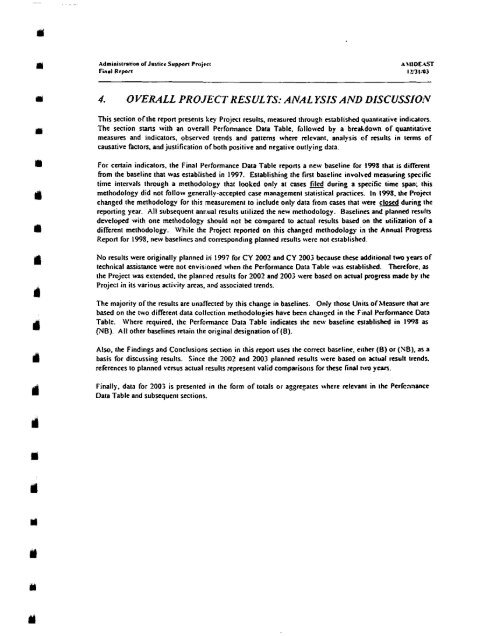2003 - usaid/ofda
2003 - usaid/ofda
2003 - usaid/ofda
You also want an ePaper? Increase the reach of your titles
YUMPU automatically turns print PDFs into web optimized ePapers that Google loves.
4. OVERALL PROJECT RESULTS: ANAL YSIS AND DISCUSSIOA'<br />
This section ofthe repon presents key Projrct results. measured thmugh established quantitative indicators.<br />
The section stans with an overall Performance Data Table. lollowd by a brrddor*n of quantitative<br />
measum and indicators, observed trends and patterns where relevant. analysis of mulls in terms of<br />
causative factors. and justification of both positive and negative outlying data.<br />
For certain indicators. the Final Performance Dam Table repons a new baselinc lor 1995 that is different<br />
from the baseline that was established in 15'97. Establishins the first baseline involved measuring sprcific<br />
time intervals through a methodology that looked only at cases ji& during a specific lime span: this<br />
methodology did not follow generally-accepted case management statistical practices. In 1991. l c Projm<br />
changed the methodology for this measurement to include only data fmm cases that \rae c- during the<br />
reporting year. All subsequent annual results utilized the new methodology. Baselines and planned results<br />
developd with one methodology should not be compared to actual results bawd on the utilization of a<br />
different methodoloa. While the Project reponed on this chaqed methodology in the Annual Progms<br />
Repon for 1993. new baselines and corresponding planned results were not established.<br />
No mults were originally planned in 1997 for CY 2001 and CY 7003 because thcx additional tuo years of<br />
technical assistance were not envisioned when the Performance Data Table \*as establishcd. Thcrcfore. as<br />
the Project was extended. the planned results for 2002 and ZOO; were based on actual progress made by the<br />
Project in its various activity areas. and associated trends.<br />
The majority ofthe results are unaffected by this chan~c in baselines. Only those Units ofh4c~ure that are<br />
based on the two different data collection methodologies have ken changed in the Final Paformancc bla Table. Where required. the Perlormancc Data Table indicates the new baseline established in 1998 as<br />
(NB). All other baselines retain the original designation of (8).<br />
Also. the Findings and Conclusions section in this repopon uses the correct bascline. enher (B) or (NB). as a<br />
basis for discussing mults. Since the ZOO? and ZOO; planned results were based on actual mult lmds.<br />
relcrences to planned versus actual results repment valid comparisons lor these final tuv years.<br />
Finally. data for ZOO; is presented in the form of totals or aggqates where releranl in thc Palcnnance<br />
Data Table and subsequent sections.

















